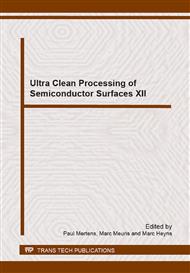p.205
p.209
p.213
p.217
p.221
p.225
p.233
p.237
p.241
Prevention of Unexpected Oxidation of Metal Layer by Removing Hydrogen Peroxide from Ultrapure Water and Diluted Hydrofluoric Acid
Abstract:
Ultrapure water (UPW) is widely used for rinsing wafers and diluting chemicals in semiconductor manufacturing processes. The quality of UPW is severely controlled, but the generation of hydrogen peroxide (H2O2) as a impurity is inevitable due to the ultraviolet irradiation in a UPW production system (Figure 1). In our survey, it is revealed that the concentration of H2O2 in UPW reaches to 10~40 μg/L level. Considering the situation, we have developed a palladium-loaded monolithic anion exchange resin (Pd-M) as a catalyst that is able to remove H2O2 from UPW down to below 1 μg/L at an extremely high flow rate (space velocity SV = 6,000 h-1), with no detectable elution of impurities [1, 2]. Furthermore, we have found that the dissolution rate of copper which is easy to be corroded oxidatively in CO2-dissolved water (CO2 UPW) [3] can be decreased to one-third by removal of H2O2 from CO2 UPW using Pd-M catalyst [4]. In this study, we present the effects of H2O2 removal from UPW and diluted hydrofluoric acid (DHF) on the surfaces of copper, molybdenum and silicon.
Info:
Periodical:
Pages:
221-224
Citation:
Online since:
September 2014
Authors:
Price:
Сopyright:
© 2015 Trans Tech Publications Ltd. All Rights Reserved
Share:
Citation:


